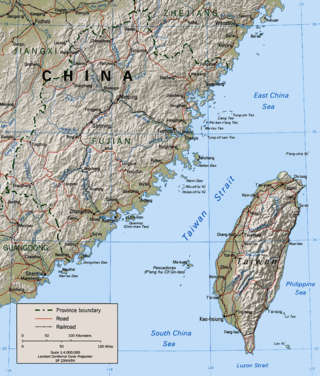Related Research Articles

The International Phonetic Alphabet (IPA) is an alphabetic system of phonetic notation based primarily on the Latin script. It was devised by the International Phonetic Association in the late 19th century as a standardized representation of speech sounds in written form. The IPA is used by lexicographers, foreign language students and teachers, linguists, speech–language pathologists, singers, actors, constructed language creators, and translators.
Hanyu Pinyin, or simply pinyin, is the most common romanization system for Standard Chinese. In official documents, it is referred to as the Chinese Phonetic Alphabet. It is the official system used in China, Singapore, Taiwan, and by the United Nations. Its use has become common when transliterating Standard Chinese mostly regardless of region, though it is less ubiquitous in Taiwan. It is used to teach Standard Chinese, normally written with Chinese characters, to students already familiar with the Latin alphabet. The system makes use of diacritics to indicate the four tones found in Standard Chinese, though these are often omitted in various contexts, such as when spelling Chinese names in non-Chinese texts, or when writing non-Chinese words in Chinese-language texts. Pinyin is also used by various input methods on computers and to categorize entries in some Chinese dictionaries. Hànyǔ literally means 'Han language'—meaning, the Chinese language—while pinyin literally means 'spelled sounds'.

Wade–Giles is a romanization system for Mandarin Chinese. It developed from a system produced by Thomas Francis Wade, during the mid-19th century, and was given completed form with Herbert A. Giles's Chinese–English Dictionary of 1892.

The Linguistic Society of Hong Kong Cantonese Romanization Scheme, also known as Jyutping, is a romanisation system for Cantonese developed in 1993 by the Linguistic Society of Hong Kong (LSHK).
The Royal Thai General System of Transcription (RTGS) is the official system for rendering Thai words in the Latin alphabet. It was published by the Royal Institute of Thailand in early 1917, when Thailand was called Siam.

Cantonese is a language within the Chinese (Sinitic) branch of the Sino-Tibetan languages originating from the city of Guangzhou and its surrounding Pearl River Delta. It is the traditional prestige variety of the Yue Chinese group, which has over 82.4 million native speakers. While the term Cantonese specifically refers to the prestige variety, it is often used to refer to the entire Yue subgroup of Chinese, including related but partially mutually intelligible varieties like Taishanese.
The Hong Kong Government uses an unpublished system of Romanisation of Cantonese for public purposes which is based on the 1888 standard described by Roy T Cowles in 1914 as Standard Romanisation. The primary need for Romanisation of Cantonese by the Hong Kong Government is in the assigning of names to new streets and places. It has not formally or publicly disclosed its method for determining the appropriate Romanisation in any given instance.
Guangdong Romanization refers to the four romanization schemes published by the Guangdong Provincial Education Department in 1960 for transliterating Cantonese, Teochew, Hakka and Hainanese. The schemes utilized similar elements with some differences in order to adapt to their respective spoken varieties.
A syllabic consonant or vocalic consonant is a consonant that forms a syllable on its own, like the m, n and l in some pronunciations of the English words rhythm, button and bottle, respectively. To represent it, the understroke diacritic in the International Phonetic Alphabet is used, ⟨U+0329◌̩COMBINING VERTICAL LINE BELOW⟩. It may be instead represented by an overstroke, ⟨U+030D◌̍COMBINING VERTICAL LINE ABOVE⟩ if the symbol that it modifies has a descender, such as in.
Sidney Lau Sek-cheung was a Cantonese teacher in the Chinese Language Section of the Government Training Division and Principal of the Government Language School of the Hong Kong Government. He had graduated bachelor of arts from Sun Yat-sen University, Guangdong, People's Republic of China.
Cantonese Pinyin is a romanization system for Cantonese developed by the Rev. Yu Ping Chiu (余秉昭) in 1971, and subsequently modified by the Education Department of Hong Kong and Zhan Bohui (詹伯慧) of the Chinese Dialects Research Centre of the Jinan University, Guangdong, PRC, and honorary professor of the School of Chinese, University of Hong Kong. It is the only romanization system accepted by Education and Manpower Bureau of Hong Kong and Hong Kong Examinations and Assessment Authority.
Wong Shik Ling published a scheme of phonetic symbols for Cantonese based on the International Phonetic Alphabet (IPA) in the book A Chinese Syllabary Pronounced According to the Dialect of Canton. The scheme has been widely used in Chinese dictionaries published in Hong Kong. The scheme, known as S. L. Wong system (黃錫凌式), is a broad phonemic transcription system based on IPA and its analysis of Cantonese phonemes is grounded in the theories of Y. R. Chao.
Wong Shik-Ling published a romanisation scheme accompanying a set of phonetic symbols for Cantonese based on International Phonetic Alphabet (IPA) in the book A Chinese Syllabary Pronounced according to the Dialect of Canton.
Hong Kong Cantonese is a dialect of the Cantonese language of the Sino-Tibetan family.
The Yale romanization of Cantonese was developed by Gerard P. Kok for his and Parker Po-fei Huang's textbook Speak Cantonese initially circulated in looseleaf form in 1952 but later published in 1958. Unlike the Yale romanization of Mandarin, it is still widely used in books and dictionaries, especially for foreign learners of Cantonese. It shares some similarities with Hanyu Pinyin in that unvoiced, unaspirated consonants are represented by letters traditionally used in English and most other European languages to represent voiced sounds. For example, is represented as b in Yale, whereas its aspirated counterpart, is represented as p. Students attending The Chinese University of Hong Kong's New-Asia Yale-in-China Chinese Language Center are taught using Yale romanization.
The Cantonese Romanisation system known as Barnett–Chao is based on the principles of the Gwoyeu Romatzyh system (GR) developed by Yuen Ren Chao in the 1920s, which he modified in 1947. The B-C system is a modification in 1950 by K M A Barnett from Yuen Ren Chao's romanisation system. It was adopted by the School of Oriental and African Studies, London (SOAS).
The phonology of Standard Chinese has historically derived from the Beijing dialect of Mandarin. However, pronunciation varies widely among speakers, who may introduce elements of their local varieties. Television and radio announcers are chosen for their ability to affect a standard accent. Elements of the sound system include not only the segments—e.g. vowels and consonants—of the language, but also the tones applied to each syllable. In addition to its four main tones, Standard Chinese has a neutral tone that appears on weak syllables.
The phonology of Burmese is fairly typical of a Southeast Asian language, involving phonemic tone or register, a contrast between major and minor syllables, and strict limitations on consonant clusters.
Standard Cantonese pronunciation is that of Guangzhou, also known as Canton, capital of Guangdong Province. Hong Kong Cantonese is related to Guangzhou dialect, and they diverge only slightly. Yue dialects in other parts of Guangdong and Guangxi provinces like Taishanese, may be considered divergent to a greater degree.
The Cantonese Transliteration Scheme, sometimes called Rao's romanization, is the romanisation for Cantonese published at part of the Guangdong Romanization by the Guangdong Education department in 1960, and further revised by Rao Bingcai in 1980. It is referred to as the Canton Romanization on the LSHK character database.
References
- ↑ "Pronunciation Guide – Initials". Sidney Lau. Retrieved 3 April 2017.
- ↑ Kataoka, Shin; Lee, Cream (2008). "A System without a System: Cantonese Romanization Used in Hong Kong Place and Personal Names". Hong Kong Journal of Applied Linguistics. 11. Chinese University of Hong Kong.
- ↑ "Certificate in Chinese Language courses for foreign students". School of Chinese. University of Hong Kong. Retrieved 2019-01-21.
- ↑ "Pronunciation Guide – Finals". Sidney Lau. Retrieved 3 April 2017.
- ↑ "Pronunciation Guide – Tones". Sidney Lau. Retrieved 3 April 2017.